Visit Sidi Bashir Mosque And Explore Its Historic Jhulta Minar In 2025
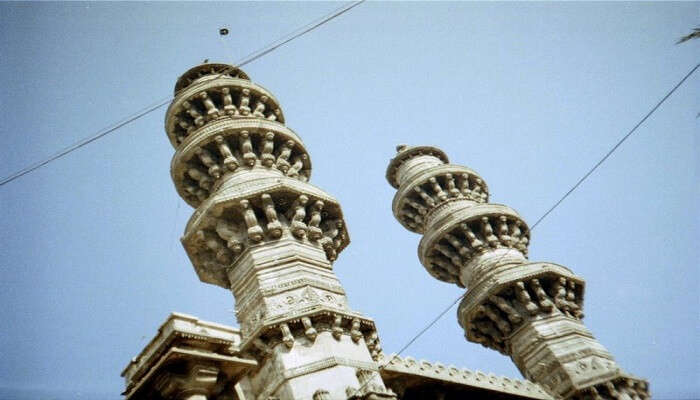
Sidi Bashir Mosque, located in the city of Ahmedabad, is one of the finest examples of mediaeval engineering, which is hard to explain even today.
Picture a pair of tall minarets that can move in response to a slight touch; one minaret vibrates, and the other responds, but the link between them does not. This architectural oddity has puzzled scholars for many years. This mosque was constructed in the 15th century during the rule of the Gujarat Sultanate and the ‘Jhulta Minar’ or the ‘Shaking Minarets’ of this mosque are not just a marvel of architecture but a mystery that still remains unsolved and attracts a lot of tourists from all over the world.
Sidi Bashir Mosque History
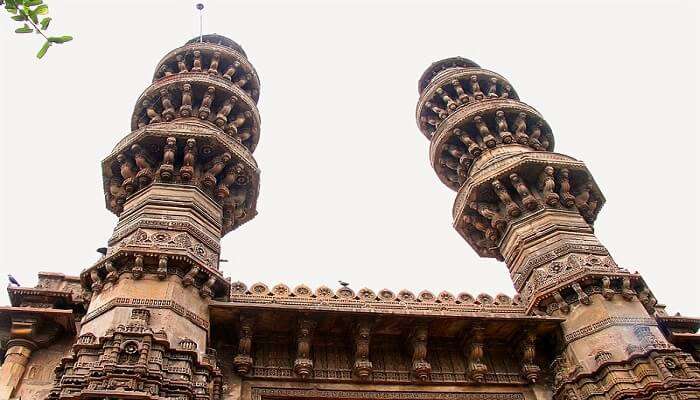
The Sidi Bashir Mosque which was built in the 15th century is a fine example of the architectural marvel of the Gujarat Sultanate. According to some historians it was built by Sidi Bashir, a faithful slave of Sultan Ahmed Shah while according to other historians it was built by Malik Sarang, a nobleman of Sultan Mahmud Begada. The mosque was originally built with a large plan and construction, but most of it was damaged during the Maratha-Mughal war in 1753 and only the central gate and the famous Jhulta Minar remain. Even today, the mosque stands as an example of the cultural and architectural history of Ahmedabad though it is partially destroyed.
Also Read: Things To Do In Ahmedabad
Architecture Of Sidi Bashir Mosque

The most interesting feature of the Sidi Bashir Mosque is the Jhulta Minar or Shaking Minarets. These three story minarets with Islamic motifs are the examples of the architectural achievements of that period. The structure of each of the minarets is such that even if one tries to push it gently, it rocks and the connected minaret rocks in the opposite direction while the central structure remains unmoved. This peculiarity has not been explained, but it is assumed that the layering and the distribution of forces in the structure of the design are the cause of this effect. Who designed these minarets is not known to this date and this has only served to fuel the mystery behind the minarets.
Places To See Near Sidi Bashir Mosque
The surrounding area offers a variety of attractions, including Adalaj Stepwell, Sabarmati Ashram, and Statue of Unity, making it a vibrant destination for both history enthusiasts and casual travellers alike. Whether you’re drawn by the architectural marvel or the cultural significance, there’s much to discover near this iconic landmark.
1. Adalaj Stepwell
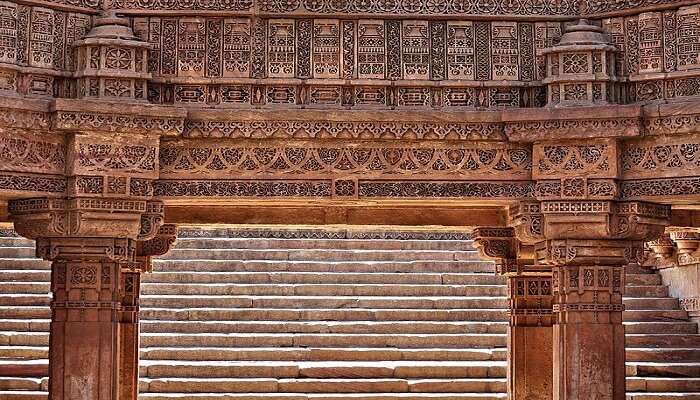
Adalaj Stepwell or Rudabai Stepwell is one of the most beautiful examples of architecture in India situated near Gandhinagar. This building was built in the year 1498 and was five stories tall and was built to supply water in the desert and also to act as a shelter for travellers. The stepwell has been carved with various scenes from mythology and floral designs which are an example of the workmanship of the period. There are many spiral staircases and platforms that are designed to provide shade from the heat to the visitors. It is a unique structure in Gujarat because of the combination of Hindu and Islamic architecture.
Opening Hours: 8 am to 6 pm
Entry Fee: INR 25/- for Indian and SAARC nationals, INR 300/- for Foreign tourists
Location: Adalaj Rd, Adalaj, Gujarat 382421
Highlight: Architecture, carvings and history
Related Post: Best Resorts Near Ahmedabad
2. Nalsarovar Bird Sanctuary

Nalsarovar Bird Sanctuary, located 66 km away from Sidi Bashir Mosque, is the largest wetland bird sanctuary in Gujarat and occupies an area of 120 sq km. With more than 200 species of birds that migrate to the area, the sanctuary is a bird watchers’ and nature lovers’ haven with flamingos and pelicans among the most common birds found in the area. The Nalsarovar Lake is a shallow lake with a number of marshy islands which makes it a perfect place for bird watching and boating. Tourists can go for a boat ride in the morning to watch the birds flying, and therefore it is a great place for wildlife lovers.
Opening Hours: 6 am to 5:30 pm
Entry Fee: INR 75 onwards
Location: Vekariya, Sanand – Nalsarovar Road, Nashik Road, Nalsarovar, Gujarat 382170, Gujarat 380001
Highlight: bird species, migratory birds, habitat diversity
3. Sabarmati Ashram
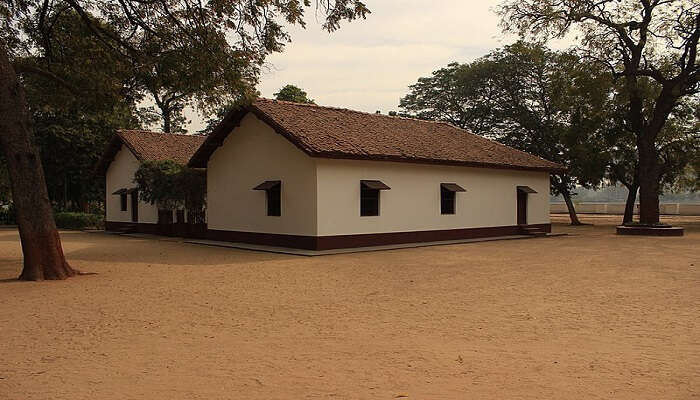
Sabarmati Ashram is situated on the banks of Sabarmati River in Ahmedabad and is important as it was one of the residences of Mahatma Gandhi and the starting point of the famous Dandi March in 1930. The ashram has now become a museum where people can see many items, letters, photographs that illustrate the life of Gandhi and his part in the fight for India’s independence. The serene environment and the fact that the ashram is an important historical site for the freedom movement of India and Mahatma Gandhi makes it a must visit for those who are interested in the history of India’s freedom struggle and the teachings of Gandhi.
Opening Hours: 10 am to 6 pm
Entry Fee: Free entry
Location: Gandhi Smarak Sangrahalaya, Ashram Rd, Ahmedabad, Gujarat 380027
Highlight: Gandhi’s focus and residence
Related Post: Tourist Places In Ahmedabad
4. Statue Of Unity
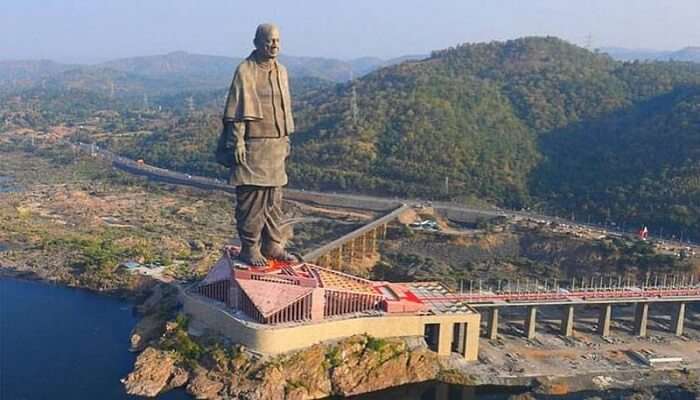
The Statue of Unity is the tallest statue in the world with a height of 182 metres and is dedicated to the ‘Iron Man of India’ Sardar Vallabhbhai Patel, and is located near the Sardar Sarovar Dam in Kevadia, Gujarat. Tourists can walk through the museum and exhibition hall devoted to Patel’s life and his role in the struggle for India’s independence. It also has a viewing gallery where visitors can view the dam and the scenic Valley of Flowers and therefore is a one-stop centre.
Opening Hours: 8 am to 6 pm
Entry Fee: INR 120 + INR 30 (Bus Charges) for Adults and INR 60 + INR 30 (Bus Charges) for Children
Location: Sardar Sarovar Dam, Statue of Unity Rd, Kevadia, Gujarat 393155
Highlight: valley of flowers, exhibition hall and world’s tallest statue
5. Lothal

Lothal is one of the most important archaeological sites of the Indus Valley Civilization which gives information about one of the oldest urban civilizations of the world. Founded as early as 2200 BCE, Lothal was a prosperous port city with well-planned urban layout and a complex dockyard which is one of the earliest in the world. The site gives the visitors an opportunity to learn about the remains of the city with the preserved residential part, markets, and drainage. The museum close by has other relics such as pottery, tools and ornaments that show the historical past of this ancient civilization.
Opening Hours: 10 am to 5 pm (Closed on Fridays)
Entry Fee: INR 5/- per person
Location: Lothal, Taluka, Saragwala, Dholka, Gujarat 382230
Highlight: dockyard, trade, artifacts
Related Post: Best Places To Visit In Vadodara
How To Reach Sidi Bashir Mosque

By Road: Ahmedabad is well connected by road and there are state and private buses from all the major cities of Gujarat. Taxis and auto-rickshaws are also readily available for local transport within the city.
By Rail: The mosque is situated close to the Ahmedabad Junction railway station, one of India’s biggest railway stations and has connectivity to most of the cities in the country.
By Air: The Sardar Vallabhbhai Patel International Airport in Ahmedabad has daily connectivity to most of the other cities in India and some international destinations as well. The mosque is easily accessible by car, just a few minutes drive from the airport.
You May Also Like To Read: Tourist Places In Ahmedabad
Sidi Bashir Mosque, along with its Jhulta Minar, is one of the examples of Gujarat’s historical and architectural heritage. It is one of the most mysterious places to visit in this part of the world; other places of interest include the Adalaj Stepwell and the Sabarmati Ashram. Do not miss the opportunity to plan your next trip to Gujarat to visit these amazing sites.
For our editorial codes of conduct and copyright disclaimer, please click here.
Cover Image Credit: yamarhythm for Wikimedia Common
Frequently Asked Questions about Sidi Bashir Mosque
When is the best time to visit Sidi Bashir Mosque?
The best time to visit is during the months of October to March as the climate is comparatively cool. You can enjoy the breathtaking views.
Is it still possible to sway the minarets of Jhulta Minar?
Because of the security reasons, people cannot get to the minarets and feel the movement as the structures are designed for.
Is there any charge that one has to pay when visiting the Sidi Bashir Mosque?
There is no charge for visiting the mosque but donations are accepted for the maintenance of the building.
Is there a possibility to have a guided tour at the Sidi Bashir Mosque?
There are no organised tours but there are local guides who can explain the history and design of the mosque.
What is the appropriate dress code when visiting the mosque?
It is advised that women should cover their bodies as much as possible because the mosque is a sacred place. They should also leave their shoes outside the mosque.
People Also Read:
Hazratbal Mosque Vijayawada Sheikh Zayed Mosque Blue Mosque

Unveil the hidden treasures of the globe and turn every travel dream into reality. As a Content Writer, I am passionate enough to craft stories from ancient wonders to modern marvels. My words paint the picture-perfect itinerary for unforgettable experiences. Let my words be your trusted guide to immerse in the diverse culture and discover the beauty of the unknown.











